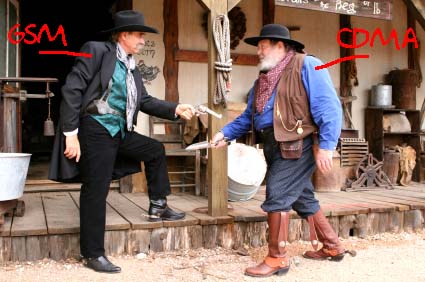 Apple vs Microsoft, Oracle vs SQL Server, VHS vs Beta… the tech world has been subject to more religious wars than you can poke a stick at. And the mobile phone business hasn’t been immune for the battles between competing standards. In Australia that battle was fought between GSM, the Global System for Mobile Communications, and CDMA, Code division Multiple Access systems for mobile phone networks.
Apple vs Microsoft, Oracle vs SQL Server, VHS vs Beta… the tech world has been subject to more religious wars than you can poke a stick at. And the mobile phone business hasn’t been immune for the battles between competing standards. In Australia that battle was fought between GSM, the Global System for Mobile Communications, and CDMA, Code division Multiple Access systems for mobile phone networks.
Back in the 1980s Australia’s first mobile phone network, owned and operated by Telstra, used an analog technology called AMPS (Advanced Mobile Phone Service). This was analog and its transmission system worked on allocating each conversation its own bit of bandwidth. As you’d imagine, it wasn’t very efficient but by the time it was put to death in 1980, it covered a lot of the Australian population.
When the decision was made to replace the analog system with a more efficient and secure digital one, there were two standards to pick from: GSM and CDMA. Naturally, rather than agree on a common standard the Australian telecommunications industry – which was at this time in flux as Telstra faced competition from Optus, Hutchison and Vodafone – chose both. The battle lines were drawn with carriers offering GSM or CDMA handsets and network access. Just make it more interesting, Telstra offered CDMA to its rural customers as it was cheaper to deploy in those settings and used GSM in urban areas. That meant that some people needed two handsets if they travelled in areas where both networks weren’t available.
Eventually, like the video shops that carried movies in both VHS and Beta, one of the standards won out. GSM came out on top and the CDMA network was finally decommissioned in 2008 when Telstra had proved to the government that their new 850MHz GSM network offered the same or better coverage than the network that was being replaced.
As a footnote to the whole GSM vs CDMA battle, Hutchison was running two brands of service. Its Orange service used CDMA and Three was a GSM service. All of their Orange customers were moved to Three with a minimum of fuss.
The GSM network is the only mobile phone network standard operating in Australia. It’s the dominant network in Europe and widely used in the US. However, within GSM there’s differentiation as the standard allows for 850, 900, 1800 and 1900MHz to be used.
Telstra’s NextG network uses the 850MHz band to deliver what’s widely recognised as the fastest GSM data network in the world. Optus hopes to achieve faster speeds using the 900MHz band as it establishes its own high speed network.
The trap for travellers is to make sure that mobile phones you buy support multiple bands so that your handset can work in different countries. Most phones are tri-band these days although there are quite a few quad-band handsets out there as well.
MobileModo is Gizmodo Australia’s look at the rise and rise of the mobile phone, from Bell’s landline to the ubiquitous mobiles of today.